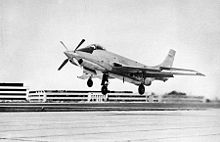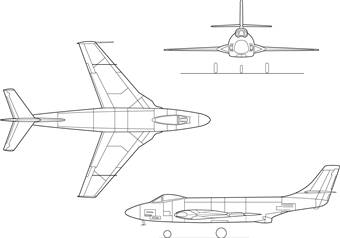
The McDonnell FH Phantom is a twinjet, straight-wing, carrier-based fighter aircraft designed and first flown during late World War II for the United States Navy. As a first-generation jet fighter, the Phantom was the first purely jet-powered aircraft to land on an American aircraft carrier and the first jet deployed by the United States Marine Corps. Although only 62 FH-1s were built it helped prove the viability of carrier-based jet fighters. As McDonnell's first successful fighter, it led to the development of the follow-on F2H Banshee, which was one of the two most important naval jet fighters of the Korean War; combined, the two established McDonnell as an important supplier of navy aircraft.
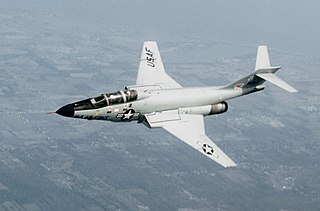
The McDonnell F-101 Voodoo is a supersonic jet fighter designed and produced by the American McDonnell Aircraft Corporation.

The McDonnell F2H Banshee is a single-seat carrier-based jet fighter aircraft designed and produced by the American aircraft manufacturer McDonnell Aircraft. It was an early jet fighter operated by United States Navy and United States Marine Corps, as well as being the only jet-powered fighter to ever be deployed by the Royal Canadian Navy. The aircraft's name is derived from the banshee of Irish mythology.
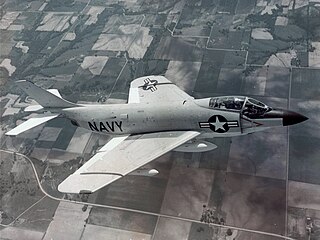
The McDonnell F3H Demon is a subsonic swept-wing carrier-based jet fighter aircraft designed and produced by the American manufacturer McDonnell Aircraft Corporation. It was the first swept wing jet fighter and the only single-engined carrier-based fighter the company produced.

The McDonnell XF-85 Goblin is an American prototype fighter aircraft conceived during World War II by McDonnell Aircraft. It was intended to deploy from the bomb bay of the Convair B-36 bomber as a parasite fighter. The XF-85's intended role was to defend bombers from hostile interceptor aircraft, a need demonstrated during World War II. McDonnell built two prototypes before the Air Force (USAF) terminated the program.

The Lockheed F-94 Starfire is a first-generation jet powered all-weather day/night interceptor aircraft designed and produced by Lockheed Corporation. It was the first operational United States Air Force (USAF) fighter equipped with an afterburner as well as being the first jet-powered all-weather fighter to enter combat during the Korean War.

The Republic F-84 Thunderjet is an American turbojet fighter-bomber aircraft. Originating as a 1944 United States Army Air Forces (USAAF) proposal for a "day fighter", the F-84 first flew in 1946. Although it entered service in 1947, the Thunderjet was plagued by such a large amount of structural and engine problems that a 1948 U.S. Air Force review declared it unable to execute any aspect of its intended mission and considered canceling the program. The aircraft was not considered fully operational until the 1949 F-84D model and the design matured only with the definitive F-84G introduced in 1951. In 1954, the straight-wing Thunderjet was joined by the swept-wing F-84F Thunderstreak fighter and RF-84F Thunderflash photo reconnaissance aircraft.

The Northrop F-89 Scorpion is an all-weather, twin-engined interceptor aircraft designed and produced by the American aircraft manufacturer Northrop Corporation. It was the first jet-powered aircraft to be designed for the interceptor role from the outset to enter service, as well as the first combat aircraft to be armed with air-to-air nuclear weapons in the form of the unguided Genie rocket. The name Scorpion came from the aircraft's elevated tail unit and high-mounted horizontal stabilizer, which kept it clear of the engine exhaust.
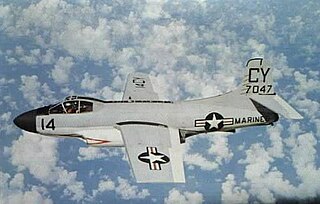
The Douglas F3D Skyknight is an American twin-engined, mid-wing jet fighter aircraft designed and manufactured by the Douglas Aircraft Company.

The Douglas F4D Skyray is an American carrier-based supersonic fighter/interceptor designed and produced by the Douglas Aircraft Company. It was the first naval fighter to exceed the speed of sound in level flight and the last fighter produced by the Douglas Aircraft Company prior to its merger with McDonnell Aircraft to become McDonnell Douglas.

The Curtiss-Wright XF-87 Blackhawk was a prototype American all-weather jet fighter-interceptor, and the company's last aircraft project. Designed as a replacement for the World War II–era propeller-driven P-61 Black Widow night/interceptor aircraft, the XF-87 lost in government procurement competition to the Northrop F-89 Scorpion. The loss of the contract was fatal to the company; the Curtiss-Wright Corporation closed down its aviation division, selling its assets to North American Aviation.

The Douglas X-3 Stiletto is a 1950s United States experimental jet aircraft with a slender fuselage and a long tapered nose, manufactured by the Douglas Aircraft Company. Its primary mission was to investigate the design features of an aircraft suitable for sustained supersonic speeds, which included the first use of titanium in major airframe components. Douglas designed the X-3 with the goal of a maximum speed of approximately 2,000 mph (3,200 km/h), but it was seriously underpowered for this purpose and could not even exceed Mach 1 in level flight. Although the research aircraft was a disappointment, Lockheed designers used data from the X-3 tests for the Lockheed F-104 Starfighter which used a similar trapezoidal wing design in a successful Mach 2 fighter.

The Convair XF-92 is an American, delta wing, first-generation jet prototype. Originally conceived as a point-defence interceptor, the design was later used purely for experimental purposes and only one was built. However, it led Convair to use the delta-wing on a number of designs, including the F-102 Delta Dagger, F-106 Delta Dart, B-58 Hustler, the US Navy's F2Y Sea Dart as well as the VTOL FY Pogo.
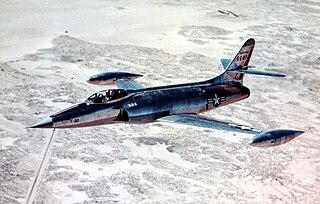
The Lockheed XF-90 was built in response to a United States Air Force requirement for a long-range penetration fighter and bomber escort. The same requirement produced the McDonnell XF-88 Voodoo. Lockheed received a contract for two prototype XP-90s. The design was developed by Willis Hawkins and the Skunk Works team under Kelly Johnson. Two prototypes were built. Developmental and political difficulties delayed the first flight until 3 June 1949, with Chief Test Pilot Tony LeVier at the controls. Embodying the experience gained in developing the P-80 Shooting Star, the XF-90 shared some design traits with the older Lockheed fighter, albeit with swept-wings; however, this latter design choice could not sufficiently make up for the project’s underpowered engines, and the XF-90 never entered production.

The North American YF-93 was an American fighter development of the F-86 Sabre that emerged as a radically different variant that received its own designation. Two were built and flown before the project was eventually canceled.

The McDonnell CF-101 Voodoo was an all-weather interceptor aircraft operated by the Royal Canadian Air Force and the Canadian Forces between 1961 and 1984. They were manufactured by the McDonnell Aircraft Corporation of St. Louis, Missouri for the United States Air Force, and later sold to Canada. CF-101s replaced the obsolete Avro CF-100 Canuck in the RCAF's all-weather fighter squadrons. The Voodoo's primary armament was nuclear AIR-2A Genie unguided air-to-air rockets, and there was significant political controversy in Canada about their adoption. Although they never fired a weapon in wartime, the CF-101 served as Canada's primary means of air defence from Quick Reaction Alert facilities at Canadian airbases. The CF-101s were retired in the 1980s and replaced with McDonnell Douglas CF-18 Hornet fighters. Many examples are preserved in museums and parks in Canada and the United States.

The Vought F6U Pirate was the Vought company's first jet fighter, designed for the United States Navy during the mid-1940s. Although pioneering the use of turbojet power as the first naval fighter with an afterburner and composite material construction, the aircraft proved to be underpowered and was judged unsuitable for combat. None were ever issued to operational squadrons and they were relegated to development, training, and test roles before they were withdrawn from service in 1950.

The Westinghouse J40 was an early high-performance afterburning turbojet engine designed by Westinghouse Aviation Gas Turbine Division starting in 1946 to a US Navy Bureau of Aeronautics (BuAer) request. BuAer intended to use the design in several fighter aircraft and a bomber. However, while an early low-power design was successful, attempts to scale it up to its full design power failed, and the design was finally abandoned, deemed a "fiasco" and a "flop".

The McDonnell 119/220 is a business jet developed and unsuccessfully marketed by McDonnell Aircraft in the late 1950s and early 1960s. Its configuration is unique for this type of aircraft, with four podded engines underneath a low wing. It is the only airplane built by McDonnell Aircraft to be marketed to civil buyers prior to the company's merger with Douglas Aircraft to form McDonnell Douglas. The jet could be outfitted for 10 passengers in a luxury executive configuration and could carry as many as 29.

The Westinghouse J34, company designation Westinghouse 24C, was a turbojet engine developed by Westinghouse Aviation Gas Turbine Division in the late 1940s. Essentially an enlarged version of the earlier Westinghouse J30, the J34 produced 3,000 pounds of thrust, twice as much as the J30. Later models produced as much as 4,900 lb with the addition of an afterburner. It first flew in 1947. The J46 engine was developed as a larger, more powerful version of Westinghouse's J34 engine, about 50% larger.



